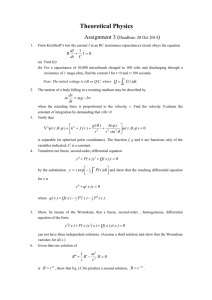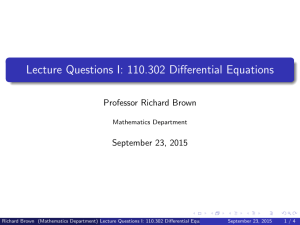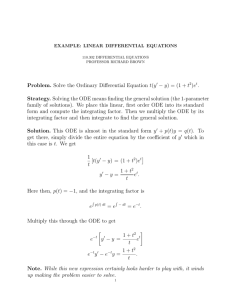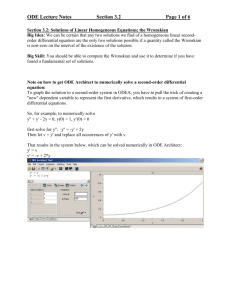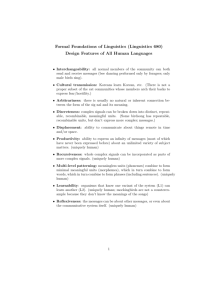Lecture Questions II: 110.302 Differential Equations
advertisement
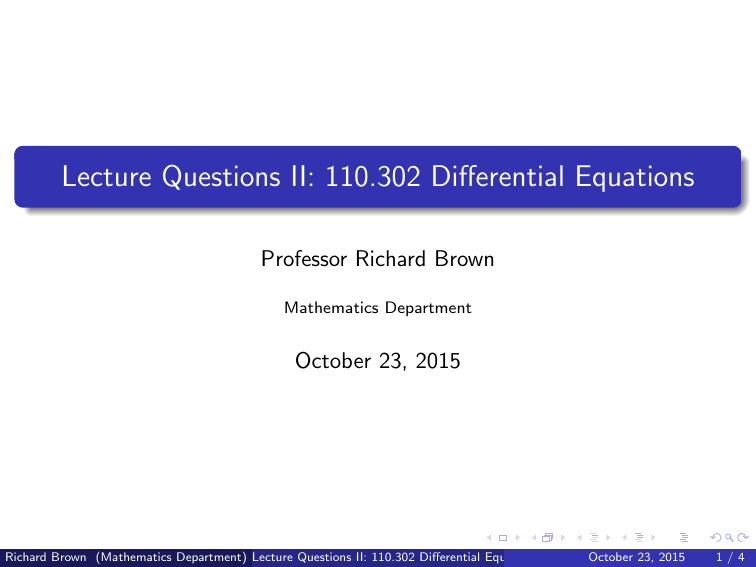
Lecture Questions II: 110.302 Differential Equations Professor Richard Brown Mathematics Department October 23, 2015 Richard Brown (Mathematics Department) Lecture Questions II: 110.302 Differential Equations October 23, 2015 1/4 Question 1 In the Variation of Parameters Method for finding a particular solution to a nonhomogeneous, second-order linear ODE L [y ] = g (t), determine which one of the following is a true statement: A. The method only works when g (t) has a certain type (a sum of products of exponentials, sines or cosines and polynomials.) B. The resulting system in the method, u10 y1 + u20 y2 = 0, u10 y10 + u20 y20 = g (t), where y1 (t) and y2 (t) comprise the fundamental set of homogeneous solutions, may be inconsistent. In this case, Y (t) = u1 y1 + u2 y2 would not exist. C. It is possible for one of the two of u1 (t) and u2 (t) to be a constant as long as the other is not. D. One must check the Wronskian to see if Y (t) is actually independent of y1 and y2 . E. None of the previous statements is true. Richard Brown (Mathematics Department) Lecture Questions II: 110.302 Differential Equations October 23, 2015 2/4 Question 2 Let ay 00 + by 0 + cy = 0, y (t0 ) = y0 , y 0 (t0 ) = y00 be a homogeneous, second-order, linear IVP with constant coefficients. If a, b, c > 0, what can we say about the long term behavior of the solutions? A. Solutions exist and are uniquely defined for all t ∈ R, and tend to either ∞ or −∞ as t → ∞. B. Solutions exist and are uniquely defined for all t ∈ R, and all tend to 0 as t → ∞. C. Solutions exist and are uniquely defined only for certain choices of a, b, and c, and where these solutions tend to depends on the initial data. D. Solutions exist and are uniquely defined always, but there is not enough information to determine where solutions go. E. Not enough information available to determine whether solutions exist and/or are uniquely defined. Richard Brown (Mathematics Department) Lecture Questions II: 110.302 Differential Equations October 23, 2015 3/4 Question 3 Determine the truth of the following two statements about the Wronskian determinant of any two solutions to y 00 + p(t)y 0 + q(t)y = 0: (1) The Wronskian can be used to determine precisely where solutions to the ODE exist and are unique. (2) If one solution is already known, one can use the Wronskian determinant to construct another independent solution. A. Both are true. B. (1) is true and (2) is false. C. (1) is false and (2) is true. D. Both are false. Richard Brown (Mathematics Department) Lecture Questions II: 110.302 Differential Equations October 23, 2015 4/4
